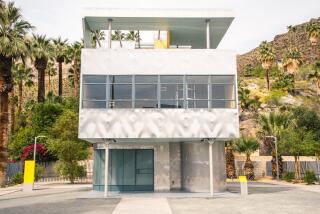MUSEUMS : Historic Houses Take Modern Approach
The nationâs bicentennial stimulated the growth and development of historic houses as museums. Now, nearly 20 years later, many are looking beyond simple restorations to make the houses more relevant to their visitors.
In that vein, the Newark Museum in New Jersey recently completed a two-year renovation of the John Holme Ballantine mansion. Determined to make the historic house live, museum representatives elected to combine period opulence with hands-on electronics during a requisite update of the heating, cooling and security systems.
In addition to eight furnished rooms, there are thematic galleries equipped with personal computers, CD-ROM, videos and printed story lines.
âWe address questions like whatâs right to own and how the meaning of an object can change over generations, as when a clothes chest evolves from a utilitarian object into a precious heirloom with only symbolic value,â said Ulysses Grant Dietz, the museumâs curator of decorative arts.
The house was built in 1885 for the son of Peter Ballantine, the founder of Ballantine beer. The father was an unassuming soul, but the son, enjoying new riches, opted for 27 rooms on Washington Park in what is now downtown Newark.
*
The Ballantine House encompassed all that could suggest wealth and social status. Local German and Italian artisans carved and gilded woodwork and paneling of oak, cherry, curly maple, mahogany, ash and sweet gum. Surfaces not paneled in wood were given stylish treatments such as molded plaster, painted canvas and embossed leather.
Architectural details have been restored. The rooms are furnished with pieces that either belonged to the Ballantines or were appropriate to their social class and period.
Among thematic galleries is the Discovery Room, formerly the music room, where visitors may try on period hats, stretch out in a Morris chair and sit at a desk and look at copies of period photo albums, menus, calling cards and the diary of a 19th-Century girl.
An interactive computer game is in a new second-floor gallery, called the Make Room. Once they master the fine art of moving a track ball around, players may select items in many different styles to furnish the room. At the end, a message tells them what style they have chosen.
For those who appreciate the art of the TV news special, there is a short video film in English and Spanish and closed-captioned for the hearing impaired in which modern-day homeowners discuss housing features most important to them.
Story boards in each of the furnished rooms introduce members of the Ballantine family by name, along with some of their servants and tradesmen. But deviating from museum tradition are story lines that create an imaginary day in the house in 1891.
In the billiards room, for example, Alice, the Ballantine daughter, and a friend are planning a party. In the dining room the table is set for a dinner party for Louis Plaut, a department store magnate described as the familyâs first Jewish dinner guest. In the reception room, James Baxter, principal of the Negro School in Newark, has come to request a donation.
âA lot of museum people donât like the idea of a made-up story,â said Kathleen Eagen Johnson, curator of Historic Hudson Valley in Tarrytown, N.Y. Although she says it is best if you can re-create an actual incident, âyou do need a vehicle to talk about history where there are gaps.â
*
âThe younger generation responds to playing with a computer screen and watching TV,â she said. âStill, museum visitors are always asking, âIs it real?â which indicates that there is great interest in the actual historic fabric of old houses.â
Documenting the Ballantinesâ activities was impossible because there is no family history. In fact, Dietz said, itâs a miracle the house is still around. An insurance company bought the mansion in 1919 after Mrs. Ballantineâs death. While it was altered for business, many similar mansions nearby were torn down as white elephants and replaced with office buildings.
The Newark Museum bought the Ballantine house in 1937 for office space. In 1976, to mark the American Bicentennial, it restored and opened the rooms on the first floor.
In addition to the billiards room, dining room, parlor and library on the first floor, the second-floor bedrooms are now open, accessible from a grand staircase.
*
Newark Museum, 49 Washington St., Newark, N.J. 07102. Phone (201) 596-6550. Open Wednesday-Sunday, noon-5 p.m. Admission is free.
More to Read
The biggest entertainment stories
Get our big stories about Hollywood, film, television, music, arts, culture and more right in your inbox as soon as they publish.
You may occasionally receive promotional content from the Los Angeles Times.










